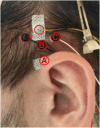Electromyographic correlates of effortful listening in the vestigial auriculomotor system
- PMID: 39959575
- PMCID: PMC11825814
- DOI: 10.3389/fnins.2024.1462507
Electromyographic correlates of effortful listening in the vestigial auriculomotor system
Abstract
Recently, electromyographic (EMG) signals of auricular muscles have been shown to be an indicator of spatial auditory attention in humans, based on a vestigial pinna-orienting system. Because spatial auditory attention in a competing speaker task is closely related to the more generalized concept of attentional effort in listening, the current study investigated the possibility that the EMG activity of auricular muscles could also reflect correlates of effortful listening in general. Twenty participants were recruited. EMG signals from the left and right superior and posterior auricular muscles (SAM, PAM) were recorded while participants attended a target podcast in a competing speaker paradigm. Three different conditions, each more difficult and requiring a higher amount of effortful listening, were generated by varying the number and pitch of distractor streams, as well as the signal-to-noise ratio. All audio streams were either presented from a loudspeaker placed in front of the participants (0°), or in the back (180°). Overall, averaged PAM activity was not affected by different levels of effortful listening, but was significantly larger when stimuli were presented from the back, as opposed to the front. Averaged SAM activity, however, was significantly larger in the most difficult condition, which required the largest amount of effort, compared to the easier conditions, but was not affected by stimulus direction. We interpret the increased SAM activity to be the response of the vestigial pinna-orienting system to an effortful stream segregation task.
Keywords: auricular muscles; effortful listening; electromyography (EMG); objective measures; superior auricular muscle.
Copyright © 2025 Schroeer, Corona-Strauss, Hannemann, Hackley and Strauss.
Conflict of interest statement
FC-S and DS were associated with Key Numerics GmbH - Neurocognitive Technologies. The remaining authors declare that the research was conducted in the absence of any commercial or financial relationships that could be construed as a potential conflict of interest.
Figures






Similar articles
-
The vestigial pinna-orienting system in humans briefly suppresses superior auricular muscle activity during reflexive orienting toward auditory stimuli.J Neurophysiol. 2024 Aug 1;132(2):514-526. doi: 10.1152/jn.00024.2024. Epub 2024 Jun 19. J Neurophysiol. 2024. PMID: 38896795
-
Vestigial auriculomotor activity indicates the direction of auditory attention in humans.Elife. 2020 Jul 3;9:e54536. doi: 10.7554/eLife.54536. Elife. 2020. PMID: 32618268 Free PMC article.
-
Assessment of Vestigial Auriculomotor Activity to Acoustic Stimuli Using Electrodes In and Around the Ear.Trends Hear. 2023 Jan-Dec;27:23312165231200158. doi: 10.1177/23312165231200158. Trends Hear. 2023. PMID: 37830146 Free PMC article.
-
Evidence for a vestigial pinna-orienting system in humans.Psychophysiology. 2015 Oct;52(10):1263-70. doi: 10.1111/psyp.12501. Epub 2015 Jul 24. Psychophysiology. 2015. PMID: 26211937 Review.
-
Assessing and Modeling Spatial Release From Listening Effort in Listeners With Normal Hearing: Reference Ranges and Effects of Noise Direction and Age.Trends Hear. 2022 Jan-Dec;26:23312165221129407. doi: 10.1177/23312165221129407. Trends Hear. 2022. PMID: 36285532 Free PMC article. Review.
Cited by
-
Understanding speech in "noise" or free energy minimization in the soundscapes of the anthropocene.Front Neurosci. 2025 Mar 14;19:1534425. doi: 10.3389/fnins.2025.1534425. eCollection 2025. Front Neurosci. 2025. PMID: 40161574 Free PMC article.
References
LinkOut - more resources
Full Text Sources
Miscellaneous

